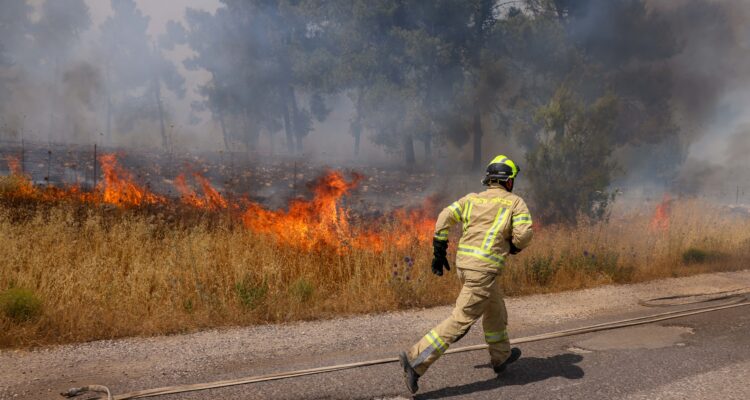According to Israel Nature and Parks Authority figures, more than 182 sq. kilometers of forestland in northern Israel have been burnt since October 7 through the end of July.
By Noah Michaeli, TPS
As northern Israel burns from 10 months of missile fire, experts are struggling to save the rare animals that call this place home.
“We have very old reserves in the area, and no hunting is allowed, meaning that we have stable populations of animals there,” Noam Ben-Moshe, director of the Center for Ecosystem Restoration and Nature-Based Solutions, told The Press Service of Israel.
“There are animals [in the region] that now exist only in northern Israel,” he stressed, explaining that mismanagement in neighboring countries has made many regional species rare or extinct.
The north hosts Israel’s largest wild mountain gazelle and wolf populations, but the fires are rapidly shrinking their ecosystems. Other animals that are often unable to escape the flames include reptiles, insects, nesting birds, small mammals, and more, Ben-Moshe said.
According to a Keren Kayemeth LeIsrael – Jewish National Fund (JNF) report released in August, the fires have dealt a particularly severe blow to the region’s population of birds of prey.
“Large forest fires typically occur in the autumn when vegetation is at its driest,” the report said, explaining that by autumn, young birds have already developed the ability to fly and leave their nests.
However, this year’s fires occurred during the spring and summer, when young animals are not capable of escaping danger.
“Among all the wildlife in these forests, the bird population is being most severely affected,” the report stated.
One of the key nesting areas for various bird species in Israel is the Biriya Forest near the Upper Galilee city of Safed which has taken heavy damage.
“Adult birds can save themselves and fly to other nesting sites when a fire breaks out, but the fate of the chicks is different… and they are burned in the nest.” the report said.
Additionally, many reptiles have perished, making it harder for Biriya’s surviving birds of prey — including a range of rare buzzards, falcons, hawks, kestrels, and owls — to find food.
The Extent of the Damage
According to Israel Nature and Parks Authority figures, more than 182 sq. kilometers of forestland in northern Israel have been burnt since October 7 through the end of July.
But the full extent of the damage won’t be known until the war is over and the area is properly mapped, a spokesperson for the Authority told TPS-IL.
More specifically in 2024, when the rocket fire increased, approximately 158 sq. kilometers of northern Israeli land — including nature reserves, forests and open undeveloped areas — have been burnt.
This includes 90 sq. km in the Golan, 50 sq. km in the Upper Galilee, 17 sq. km in the Lower Galilee and 15 sq. km in the Carmel region around Haifa, according to the JNF.
While most of the fires are caused by Hezbollah, Israeli military activities also damage create unfortunate and unavoidable damage, Ben-Moshe noted.
The army “must open supply and logistics routes in the areas they’re defending, even if this means cutting through sections of forest or nature reserves to do so,” he explained to TPS-IL.
The Israel Defense Forces “understands the issues and is doing whatever possible to mitigate environmental damage,” Ben-Moshe stressed. “We started building a plan with the IDF for what steps we will take to repair the land once it is no longer an active combat zone.”
Yaron Cherka, JNF’s chief ornithologist, told TPS-IL, “We have a lot of rehabilitation work ahead of us. We are praying for a quick end to the war and hoping for the swift restoration of the destroyed habitats.”
None of the experts who talked to TPS-IL was prepared to estimate how long or what it would cost to rehabilitate the northern lands, as the damage is still ongoing.
Nearly 80,000 Israelis were forced to evacuate their homes near the Lebanon border when Hezbollah began launching rockets and drones in October.
Hezbollah leaders have said they will continue the attacks to prevent Israelis from returning to their homes. The attacks have killed 26 civilians and 18 soldiers on the Israeli side.
Israeli officials have been calling for Hezbollah to be disarmed and removed from southern Lebanon in accordance with UN Security Council resolution 1701, which ended the 2006 Second Lebanon War.





